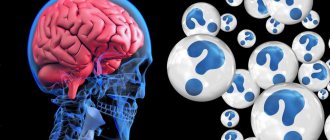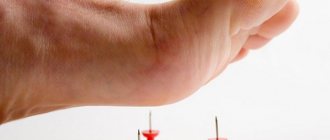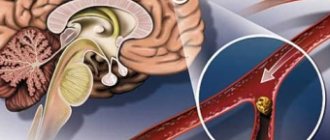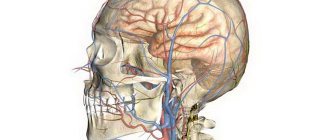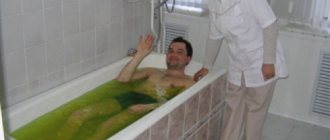What is delirium tremens
Medical representatives understand this condition as delirium delirium syndrome. Delirium tremens occurs in persons suffering from the second and third stages of addiction. The first symptoms of delirium appear 2-3 days after leaving a long binge. The pathogenesis of fever has not yet been identified, but there is an established opinion that the syndrome occurs due to a disruption in the connections between the neurotransmitters of the central nervous system. Delirium tremens develops due to:
- organic damage to brain structures;
- long-term drinking conditions;
- consumption of low-quality alcoholic products;
- the presence of somatic pathologies in the dependent person (bronchial asthma, neurodermatitis, stomach ulcers, hypertension).
Dangers of psychosis
An attack of delirium (delirium tremens) is an acute form of alcoholic psychosis. More than 30% of all alcohol addicts experience it. The manifestation of this condition is more common in people with stages II and III of addiction. This consequence of alcoholism leads to mental disorders of varying severity. In delirium, the sufferer can show aggression, experience fear, become hysterical, etc. This condition is dangerous not only for the patient himself, but also for those around him.
In alcoholic delirium, a person is capable of any unpredictable actions. He can injure himself, burn down his home, throw out things and furniture. The thinking center suffers from intoxication and lack of oxygen. The cardiovascular system, liver and other organs are in a negative state. Without timely assistance, a person may die.
According to doctors, death from delirium tremens occurs in 10-15% of cases. There is no such risk when providing specialized care. You can get rid of the pathology at home, but only with mild symptoms. It is also possible to get rid of delirium tremens at home if the patient himself understands his condition (controls himself) and strives to get out of it. In case of acute manifestations, treatment can only be carried out in a hospital setting.
In humans, delirium tremens most often begins after a long binge. It appears 2-3 days after stopping drinking alcohol. According to experts, alcohol addicts stop producing certain hormones. Alcohol becomes the only means of maintaining life. A sharp refusal of it is perceived by the body as stress, the strength of which can vary. In acute forms, after passing through a dangerous recovery period (4-7 days), pathological processes of the nervous system may develop, which in their manifestation are delirium tremens.
Read also: How to make an alcoholic quit drinking using folk remedies
There may also be other reasons for the development of this pathological condition:
- excessive alcohol consumption;
- previous head injuries;
- chronic pathologies of internal organs and systems.
The pathogenesis of delirium tremens is poorly understood. Today, experts are of the opinion that in addition to the signs of intoxication of the body, disturbances in the connections of neurotransmitters of the central nervous system are added.
Symptoms of delirium tremens
Delirium is a common form of alcoholic psychosis. Clinically, the condition is characterized by tactile, visual, and auditory hallucinations, hyperthermia, and sleep disturbances. The first attack of fever is preceded by a long binge drinking high doses of alcohol. The syndrome then develops after short episodes of alcohol consumption. In 10% of cases, the development of psychosis is preceded by single or multiple seizures. Other symptoms of delirium include:
- nausea, vomiting;
- headache;
- incoherent speech;
- mental agitation, anxiety;
- increased blood pressure, increased heart rate;
- tremor of the limbs;
- yellowing of the eyes.
- Effective remedies for toenail fungus
- Antihelminthic drugs
- Lumbodynia of the lumbar spine
Alcohol delirium
With prolonged and excessive consumption of alcoholic beverages, metal-alcohol psychoses develop. They are divided into several types, one of which is delirium tremens.
Alcoholic delirium is a type of acute alcoholic psychosis that usually occurs in people who have abused alcohol for 7-10 years. Another name for the disease is “delirium tremens” or “squirrel”. The name "delirium tremens" comes from the Latin Dtlirium tremens, which means "shaking stupor."
Delirium usually occurs in people with second and third degree alcoholism. It is less often observed after violent long-term alcoholic libations by people who do not suffer from alcoholism at all. Moreover, contrary to popular belief, the symptoms of “delirium tremens” appear some time after a sharp cessation of alcoholic beverages and almost never while taking them.
There are several types of delirium:
- Classic or typical look. Signs of this species appear gradually. There are several successive stages.
- Lucid. Symptoms appear very quickly. There are no hallucinations. This type of delirium is characterized by unstable coordination, trembling of the arms and legs, and the patient develops a feeling of constant anxiety and fear.
- Abortive. There are short-term hallucinations, feelings of fear and anxiety are pronounced. Usually it either resolves quickly or progresses to a more complex form of delirium.
- Professional type of delirium. Acute manifestations are characterized by unconscious performance of professional movements.
- Mussitizing. A type of delirium, which is a complicated form of professional. It is characterized by severe clouding of consciousness and a pronounced lack of coordination of movements.
- Atypical appearance. This is the most complex form of alcoholic psychosis. Usually observed in people who have previously experienced several other types of delirium. The symptoms of the disease are similar to those of schizophrenia.
Stages of the disease
In its development, the disease “delirium tremens” goes through several stages of development:
- First stage (threatening delirium). Signs of the disease appear unclear. The patient is fully aware of himself. Usually the condition returns to normal without seeking medical help.
- Second stage (complete delirium). The symptoms of the disease are pronounced. Treatment at home does not bring results. If emergency treatment is not used, it usually goes into the third stage.
- Stage three (life-threatening delirium). All signs of the disease are clearly expressed: hallucinations, delusions, lack of coordination, the reaction to external stimuli is reduced or absent altogether, blood pressure is very low (unlike the previous stages), the patient ceases to be aware of himself. At this stage of delirium, recovery is very problematic. A person can return to life with mental defects. Death cannot be excluded (10% of cases).
Causes of the disease
The main cause of the disease is alcoholism. People who systematically abuse alcohol experience severe binges that last for several days or even weeks. When exiting (removing with medical help) from such binge drinking, symptoms of delirium very often appear. An important factor is also the consumption of poor quality alcohol: surrogates, technical means, medications that contain alcohol. A person who has suffered a traumatic brain injury is also at risk.
Sometimes delirium can develop due to physical or mental stress. For example, a person who had taken a large dose of alcohol was returning home and was physically injured on the way. Once in the trauma department, he experiences physical pain along with withdrawal symptoms. A change of situation and a difficult moral state aggravate the patient’s situation. All these factors can provoke the manifestation of “delirium tremens”.
Symptoms of “delirium tremens”
As a rule, symptoms of delirium tremens appear the next day after drinking alcohol. Less often this happens on the fourth or fifth day. The patient complains of sleep disturbances (frequent waking up, nightmares, the person does not feel rested after sleep). A severe headache appears, sometimes nausea and vomiting. There may be signs of incoordination and incoherent speech. The patient experiences a feeling of anxiety, fear, anxiety.
The disease can be recognized by the occurrence of hallucinations. They can be both auditory and visual. The most common hallucination of patients with alcoholic delirium is the feeling of the presence of various insects (beetles, cockroaches, spiders, etc.) under the skin. At the same time, the patient tries to crush them, causing physical injury to himself. Sometimes a person hears voices that call on him to do something. This is often the cause of suicide.
The behavior of people susceptible to this disease is characterized by inadequacy. There are very sharp mood swings: from hyperactivity to deep depression.
It is worth mentioning the somatic symptoms of manifestation . First of all, these include:
- a sharp increase in body temperature (up to 40 degrees);
- blood pressure is also very high (180 and above);
- trembling of extremities (arms, knees);
- profuse sweating.
Stages of delirium tremens
The syndrome of alcoholic delirium progresses as the patient's mental state worsens. The latter talks to invisible creatures, gets scared, shows excessive motor activity, and becomes hysterical. Later, these symptoms are accompanied by restless sleep. The severity of clinical manifestations is determined by the stage of delirium.
| Delirium stage | Manifestations |
| Korsakov psychosis | Attention, memory, sleep disorders, neurological disorders |
| Rave | Mental agitation, anxiety, aggression |
| Severe stage | Visual, tactile, auditory hallucinations |
Symptomatic picture
Let's consider the manifestations of alcoholic delirium, which often manifest themselves in drunkards. The first symptoms of delirium tremens are:
- a sharp increase or decrease in blood pressure;
- chills, tremors in the limbs, increased body temperature;
- sleep is disturbed, the patient constantly wakes up, he periodically has nightmares;
- increased sweating;
- inhibition of brain activity, due to which a person begins to speak slowly, slurred, and sometimes stutters;
- aggression and overexcitement suddenly turn into apathy and lethargy;
- a person can talk to voices or run somewhere, scream, run away from someone;
- heart rhythm disturbances.
We invite you to familiarize yourself with the Rating of vodka 2020 in Russia by quality: Alfa and Lux alcohol.
Alcohol delirium also affects a person’s appearance. His eyes turn yellow, his complexion changes, and his tongue becomes covered with a white coating.
Auditory and visual hallucinations are equally common symptoms of delirium tremens. After drinking, a person may see some scary creatures, insects or animals. As a result of this, the patient behaves inappropriately, trying to get rid of such visions.
First aid
The acute phase of fever can last 3-7 days. At the first attack of alcoholic delirium, a person should be given first aid. Remember, do not swear or shout at the patient. Try to calm him down, put him in a horizontal position. If the alcoholic is aggressive, securely tie his upper and lower limbs. Then call an ambulance. Before medical personnel arrive, try to follow the following algorithm of actions:
- Put the patient to bed, remove objects that could cause injury to himself.
- Provide the person with a fever with plenty of fluids and the necessary level of coolness (a cool shower or an ice pack).
- Give the alcohol-dependent person sedatives (Diphenhydramine, Piracetam);
- Calm the patient with quiet conversations.
Forms of the disease
Typical
The clinical picture develops gradually. The disease progresses smoothly.
Lucid
In this case, acute psychosis occurs. Fear, anxiety, and lack of coordination of movements are characteristic of this form of the disease. However, the person does not have hallucinations.
Abortive
This form is characterized by increased anxiety in the person suffering from delirium delirium. Hallucinations appear in the form of fragments, delusional ideas appear in the form of fragments.
Professional
A severe form of the disease in which amnesia occurs. Patients can only perform normal movements that they often do.
Mussitating
Occurs after the end of the professional stage. Characterized by severe clouding of consciousness and movement disorders.
Atypical
In this severe case, delirium tremens is similar to schizophrenia. It develops in those patients who have had the disease once or twice.
Treatment of delirium tremens
Treatment of delirium delirium syndrome is carried out in specialized medical institutions. When asked whether delirium tremens can go away on its own, doctors answer with a categorical “no.” In most cases, an alcohol addict is placed in a psychiatric hospital, where he receives special treatment. Such measures are necessary to ensure that a person during acute delirium does not cause harm to himself or others. In a situation where it is not possible to seek medical help, treatment of delirium tremens at home is carried out using:
- Normalization of night rest - involves the use of sleeping pills. A good night's rest is an important condition for a person to overcome the syndrome of alcoholic delirium.
- Increasing the amount of fluid consumed is based on compliance with the drinking regime and forcing diuresis during the treatment of delirium.
- Detoxification – measures to remove toxic substances (inducing vomiting, taking sorbents, enemas).
- How to cook boiled pork in the oven at home. Recipes for preparing delicious boiled pork with photos and videos
- Sesame - beneficial properties and contraindications
- Registered letter DTI - what is it?
Therapy according to the Popov method
Proper treatment of delirium is possible only in a psychiatric hospital or drug treatment clinic. It is extremely difficult to get out of an acute state of fever on your own. Drug therapy for alcoholic delirium should be carried out under the strict supervision of specialists. However, in cases where the provision of qualified assistance is impossible for various reasons, it is allowed to use Dr. Popov’s technique. When answering how to treat delirium tremens at home using this method, doctors recommend giving the patient a mixture of the following components:
- distilled water (100 g);
- three tablets of Luminal/Phenobarbital
- 15-20 g of pure medical alcohol.
These components are thoroughly mixed. The ready-made mixture for treating delirium tremens at home is drunk by alcoholics in one go. In a situation where Phenobarbital or Luminal (antiepileptic drugs from the barbiturate family) are not available, severe delirium tremens can be treated at home with medications with similar pharmacological effects on the body:
| Analogue | Active substance |
| Freesium | Clobazam |
| Difenin | Phenytoin |
| Keppra | Levetiracetam |
| Suxilep | Ethosuximide |
| Tebantin | Gabapentin |
| Diuremide | Acetazolamide |
| Valproate | Valproic acid |
ethnoscience
The phenomenon of alcoholic tremens has been known to people for a long time. Alternative medicine offers many ways to relieve symptoms of acute delirium at home. Remember, if symptoms of psychosis appear, the safest way out of this situation is to seek qualified medical help. In the first stages, treatment of delirium tremens at home can be carried out using the following folk remedies:
- Bay leaf infusion for the treatment of alcoholic delirium. Place a couple of crushed laurel leaves and a few lovage roots in a glass container, pour in 100 ml of vodka. Leave the composition for 7-8 days. Filter the finished infusion and give it to the patient, after dissolving 3-4 drops of the product in 50 ml of water. Take an anti-delirium medication three times a day.
- Infusion of wormwood and yarrow. Dry raw materials (25 g each) pour 100 ml of vodka and leave in a glass container for 10-12 days. It is recommended to take the composition 2 tsp. twice a day.
- A decoction of a collection of medicinal herbs. Take 20 g of yarrow, thyme, and wormwood and pour a glass of boiling water over the dry mixture. Infuse the product for 1-2 hours, after which it is drunk in one dose.
- Hellebore infusion for alcoholic delirium. Pour boiling water over the dry herb and let it brew for 30 minutes. Ready-made infusion for the treatment of delirium, drink ⅓ glass three times a day.
How to recognize
Delirium tremens does not manifest itself in a drunk person - psychosis occurs 2–5 days after stopping alcohol consumption. Delirium is preceded by withdrawal symptoms:
- tremor of the limbs;
- headache;
- nausea;
- vomit;
- convulsions.
Signs of exacerbation of delirium are expressed in hallucinations. The nature of fever is always individual:
- Tactile “glitches” - it seems that someone is touching your arms and legs, non-existent insects are crawling on your skin.
- Visual delirium - a person sees strange creatures (“he’s drunk himself to hell”, “a meeting with a squirrel has begun”).
- Auditory hallucinations - the patient hears voices ordering him to do something or imposing ideas (for example, that a husband has a wandering wife or neighbors are spies).
Read also: How to treat the liver after alcohol
Against the background of hallucinations, persecution mania, increased aggressiveness, and attacks of jealousy appear. In this state, a person becomes dangerous to himself and others.
Post-alcohol fever is always accompanied by mental and somatic abnormalities. In addition to hallucinations, delirium is characterized by: insomnia, lack of appetite, increased nervousness, sweating, rapid heartbeat, increased blood pressure.
Delirium tremens is an unstable condition. Periods of hallucinosis occur suddenly and stop just as abruptly, aggression is replaced by increased friendliness, excitement is replaced by drowsiness. Periods of remission (when a person comes to their senses) last from a few minutes to a couple of hours.
Treatment methods at home
After an acute attack of delirium tremens has been relieved, comprehensive measures are taken to prevent relapses and help avoid the negative consequences of alcohol (secondary diseases of the heart, gastrointestinal tract, excretory system). If the family prefers treatment at home to the clinic, they adhere to the following scheme:
- Give medicine for high blood pressure and temperature.
- For increased excitability and insomnia, give a sedative.
- The first day a fast is useful (provided you drink plenty of fluids).
- From the second day, dietary nutrition is introduced (the patient needs a lot of carbohydrates and vitamins; fatty foods are excluded).
An outdated method of dealing with fever: the addict was given alcohol to drink in a dose that did not cause severe intoxication. This reduced the severity of psychosis or stopped it completely. Every day the amount of alcohol was reduced, gradually eliminating it. Now doctors do not recommend treating delirium in this way - it helps against squirrels, but aggravates withdrawal symptoms and provokes complications of diseases caused by alcoholism.
Traditional methods
Honey is a folk remedy against fever. Due to the large amount of potassium in the composition, it helps relieve symptoms of somatic disorders and reduce cravings for alcohol. On the first day of delirium, the patient is given 2 tablespoons of honey every hour. Then, until the end of the week, it is enough to eat 1 spoon 3 times a day.
A patient with delirium tremens is helped by a decoction of oat and calendula seeds, which soothes and improves metabolism. To prepare a decoction at home, take 100 g of oats and 10 g of calendula flowers, add 2 liters of water and boil for 40 minutes. Drink the remedy for delirium 3 times a day before meals, half a glass.
Chamomile tea will help you calm down. An infusion with thyme is given at night to avoid insomnia. An alcohol tincture with St. John's wort and wormwood helps against hallucinations (no more than 3 teaspoons).
Medicines
For delirium, medications are prescribed that relieve excitability, restore metabolism, and normalize blood pressure and temperature. Names of common medications:
- Sedatives – extract of Valerian, Motherwort, Glycine, Biotredin, Novo-passit.
- Medicines for hyperthermia and high blood pressure - Paracetamol, Panadol, Theraflu, Papazol, Capoten.
- Medicines that restore blood circulation and prevent thrombocytosis - Magnesia solution, Vinpocetine, Telektol, Felodipine.
- Medicines to improve metabolic processes - Reopoliglucin, Panangin, sodium bicarbonate.
Attention: for delirium tremens, medications from the group of benzodiazepines (Tazepam, Phenazepam) and phenobarbitals (Corvalol, Valocordin, Valoserdin) are contraindicated. Medicines can trigger new episodes of hallucinations. The sedatives Afobazole and Phenibut do not cause complications, but they cannot cure delirium.
Delirium tremens develops after prolonged drinking and subsequent abrupt cessation of alcohol. If you quit binge drinking gradually, the risk of developing squirrel disease is reduced. To completely reduce the risk of delirium to zero, it is better to remove an alcoholic from binge drinking not at home, but in a clinic. Detoxification, restoration of pH, electrolyte balance help normalize the functioning of internal organs, metabolic processes and prevent the development of post-alcohol psychosis.






